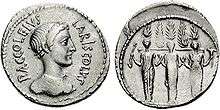Querquetulanae
In ancient Roman religion and myth, the Querquetulanae or Querquetulanae virae were nymphs of the oak grove (querquetum) at a stage of producing green growth. Their sacred grove (lucus) was within the Porta Querquetulana, a gate in the Servian Wall.[2] According to Festus, it was believed that in Rome there was once an oakwood within the Porta Querquetulana onto the greening of which presided the virae Querquetulanae.[3]
In Festus
In his entry on the Querquetulanae, Festus says that their name was thought to signify that they were nymphs presiding over the oak grove as it began to produce green growth, and that the Porta Querquetulana was so called because this kind of woodland (silva) was just within the gate.[4]
Festus says that virae in archaic Latin meant feminae, "women," as if it were the feminine form of vir, "man", and that the words virgines (singular virgo) and viragines (virago) reflect this older usage. Virgo, from which the English word "virgin" derives, meant a young woman who had just reached the age to be with a man (vir): in the Etymologies of Isidore, "she is said to be a virgo on account of her youthful bloom and vigor" (viridiori aetate).[5] In ancient etymologies, the concepts of vis (plural vires), "power, force, energy", and viriditas, "flourishing vigor", were thought to belong to a semantic group that included vir, virtus, and the virgo or vira who possessed "youthful vigor, growth, fertility, freshness, and energy".[6]
Denarius of Accoleius Lariscolus
A denarius issued by Publius Accoleius Lariscolus around 43–41 BC has sometimes been thought to represent the Querquetulanae on its reverse side. In this view, the head on the obverse represents a bust of Acca Larentia.[7]
A.B. Cook interpreted the three female figures on the reverse as "archaistic caryatids" bearing a beam on which five trees are supported. He saw the nymph on the left as holding a bow, and the one on the right holding a lily. The trees, however, he identified as more likely to represent larches (larices, singular larix), from which he derives the name Lariscolus ("young larch"), hence embodying the sisters of Phaëton transformed to larches.[8] Alföldi established the currently dominant view that the reverse represented a "triple goddess" statue in a cypress grove, with Diana Nemorensis on the obverse to represent the origin of the gens Accoleia in Aricia.[9] Diana, however, had an affinity with the oak, and had an ancient sanctuary on the Mons Querquetulanus (see below).[10]
Lares Querquetulani
The Lares Querquetulani ("tutelaries of the oak grove") had a shrine (sacellum) on the Esquiline.[11] These Lares may be connected to the Querquetulanae, depending on where their grove is to be located.[12] One of the former peoples listed by Pliny who participated in the Latin Festival were the Querquetulani.[13] Palmer thought their name in conjunction with the Lares Querquetulani and the Querquetulanae virae indicated the existence of a curia called Querquetulana, since only a few names of the thirty curiae are known.[14] The Querquetulanae virae may have also have been tutelaries of the Latin Querquetulani.[15] As indicated by inscriptions, in general Lares and nymphs might be the joint recipients of cultus in Italy and share the same sacred space.[16]
References
- ↑ Arthur Bernard Cook, Zeus: A Study in Ancient Religion (Oxford University Press, 1924), vol. 2, p. 402; Robert E.A. Palmer, The Archaic Community of the Romans (Cambridge University Press, 1990, 2009), p. 118; Mark D. Fullerton, The Archaistic Style in Roman Statuary (Brill, 1990), pp. 15–16.
- ↑ Lawrence Richardson, A New Topographical Dictionary of Ancient Rome (Johns Hopkins University Press, 1992), p. 263.
- ↑ Festus p. 261 L s.v.
- ↑ Querquetulanae virae putantur significari nymphae praesidentes querqueto virescenti, quod genus silvae iudicant fuisse intra portam, quae ab edo dicta sit Querquetularia: Festus-Paulus p. 314 in the edition of Lindsay.
- ↑ Isidore of Seville, Etymologiae 11.2.21; Carlin A. Barton, Roman Honor: The Fire in the Bones (University of California Press, 2001), p. 42, note 44; see also Isidore 11.2.23 and 12.1.32, and Servius, note to Bucolics 3.30.
- ↑ Barton, Roman Honor, pp. 41–42.
- ↑ Cook, Zeus, vol. 2, p. 402.
- ↑ Cook, Zeus, vol. 2, p. 402.
- ↑ Fullerton, The Archaistic Style, pp. 15–16.
- ↑ Cook, Zeus, vol. 2, p. 400.
- ↑ Varro, De lingua latina 5.49.
- ↑ In the view of Richardson, they were not connected to the Porta Querquetulana and its grove; A New Topographical Dictionary, p. 233.
- ↑ Pliny, Natural History 3.69.
- ↑ Palmer, The Archaic Community of the Romans, pp. 172–173.
- ↑ Jean Bayet, Histoire politique et psychologique de la religion romaine (Payot, 1969, 2nd ed.), p. 27.
- ↑ Hartswick, The Gardens of Sallust, p. 14; Cook, Zeus, vol. 2, p. 402.
